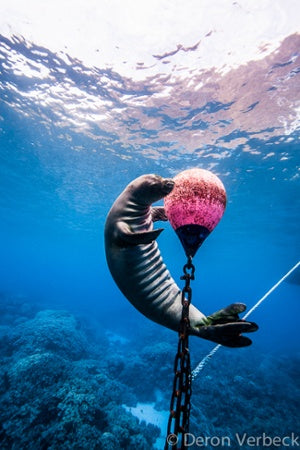
Labor of Love - Freediving with an Endangered Hawaiian Monk Seal

Meet B1819, he’s a five-year-old critically endangered Hawaiian Monk Seal born on the Big Island of Hawaii. Back in 2010 he had just turned three when he arrived in Kealakekua Bay. This alone was an unexpected treat as there are only six resident Hawaiian Monk Seals on the Big Island of Hawaii, approximately 100 animals in the Main Hawaiian Islands and less than 1000 left in the entire Island Chain.

The had been there for three days and I had been getting in with him to shoot photos. He was there because he was getting ready to molt. Hawaiian Monk Seals not only loose all of their fur, but they also loose a layer of skin as well, which as you can imagine would be very itchy. So B1819 had found a great place that he could scratch and hang out in relative comfort.
There is a mooring in the bay that has been used by a snorkeling company for many years and B1819 was using this mooring as a scratching post. He would dive down about seven or eight feet to the mooring ball and hold onto it, then rub his face and back on the chain before surfacing for another breath of air. I would float about fifteen to twenty feet away breathing and then would dive down to the bottom to see what he would do. He would watch me very carefully, studying my movements then would dive down to get a closer view. He would swim around moving closer and closer, then when he figured that I was not a threat or he was bored he would move back over to the mooring and continue rubbing on the chain. He would stop every so often to pose in very interesting and almost human like poses. I was able to capture many of these entertaining poses before he decided to do something that shock and amused me even more.

The snorkel boat, which is a large catamaran, had come into the bay and tied off to the mooring floating directly over the mooring ball. This didn’t seem to bother B1819. He continued to surface in between the hulls and diving down to mooring ball and rubbing on the chain as if the large catamaran wasn’t even there. I don’t use a flash and rely on ambient light for my photos so shooting directly under the catamaran in the shade was out of the question.
So I started diving about thirty feet away down to a rubble patch on the bottom about seventeen feet deep and would lay on the bottom motionless for as long as I could. When I would need a breath I would surface, breathe for a few minutes, then dive again. At first B1819 wasn’t interested in me any more and was content to rub on the chain in the relative safety under the catamaran. Then after a few of my dives his curiosity spiked and came to investigate, but what happened next was the most amazing thing.

He swam from the surface to the mooring ball watched me for a few seconds then continued down until he stopped about three feet from the bottom. With three extremely hard strokes of his fore-flippers towards the bottom he blew up a cloud of rubble, sand and sediment into the water column. He sank down into the cloud and rested on the bottom facing me covered completely by the cloud. This cloud was so thick I could make out his shape, but couldn’t see him clearly.
He would turn his head side to side checking his peripheral as if playfully searching for me. Then he slowly moved towards me through the dust poking his head out of the cloud to see if I was still there. I raised my camera very slowly to capture this amazing moment and fired off a few shots. I was able to get one shot of this magical moment just as his head was poking from the cloud of dust before I had to surface for another breath of air.
I have spoken with a few marine mammal experts that could not tell me what this particular behavior was used for. They have also said they had never seen nor heard of this behavior before. Could it be that the Hawaiian Monk Seals use this to ambush fish prey? Or could they use it for self defense from a predator as somewhat of a “smoke screen”? We may never know.
All I know is I was able to share an encounter with this extremely rare and critically endangered animal and witness a behavior that possibly no one else has ever seen before. I feel very lucky to live in Kona, Hawaii where I have the opportunity to have encounters with these and other rare and endangered animals.

_________________________________________________________________________________________________________







Leave a comment
This site is protected by hCaptcha and the hCaptcha Privacy Policy and Terms of Service apply.